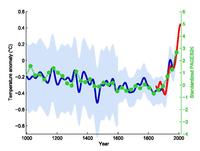
Photo from wikipedia
In the Era of exponential data generation, increasing the number of paleoclimate records to improve climate field reconstructions might not always be the best strategy. By using pseudo-proxies from different… Click to show full abstract
In the Era of exponential data generation, increasing the number of paleoclimate records to improve climate field reconstructions might not always be the best strategy. By using pseudo-proxies from different model ensembles, we show how biologically-inspired artificial intelligence can be coupled with different reconstruction methods to minimize the spatial bias induced by the non-homogeneous distribution of available proxies. The results indicate that small subsets of records situated over representative locations can outperform the reconstruction skill of the full proxy network, even in more realistic pseudo-proxy experiments and observational datasets. These locations highlight the importance of high-latitude regions and major teleconnection areas to reconstruct annual global temperature fields and their responses to external forcings and internal variability. However, low frequency temperature variations such as the transition between the Medieval Climate Anomaly and the Little Ice Age are better resolved by records situated at lower latitudes. According to our idealized experiments a careful selection of proxy locations should be performed depending on the targeted time scale of the reconstructed field.
Journal Title: Scientific Reports
Year Published: 2020
Link to full text (if available)
Share on Social Media: Sign Up to like & get
recommendations!